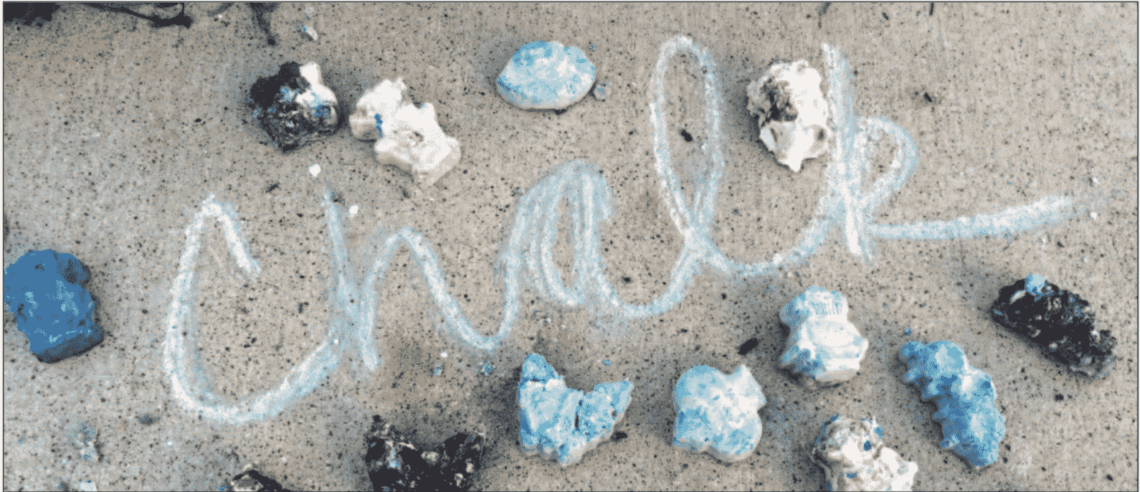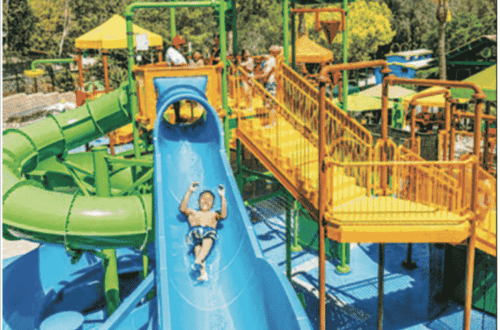
Hands On Chalk Art
By Jennifer K. Mahal

What You’ll Need
CHILD SAFE CHALK
* 1 1/5 cups cornstarch
* 1 cup water
* mixing bowl
* stirrers
* small wax-lined paper cups
* Food coloring
PARIS CHALK
* 1 1/2 cups plaster of paris (can be found at craft stores)
* 3/4 cup warm water
* 2-4 disposable containers (large yogurt containers work well)
* popsicle sticks or disposable spoons
* tempera paint
* small wax-lined paper cups
* Optional: silicon mold
The lazy days of summer are a wonderful time to play hopscotch, race your friends to a finish line and draw funny faces on your walkway. What do all of these things have in common? To do them, you need chalk!
While the colored chalk we use on our sidewalks is made by people, you can find chalk in nature. The White Cliffs of Dover on the coast of England are made of chalk. Chalk is actually a form of limestone, which is a rock made up of the shells and skeletons of small sea creatures. The main two minerals in it are calcium — the stuff that makes your bones hard — and aragonite, which makes the shimmery layer in pearls and shells. Together these minerals create calcium carbonate, a soft rock you can draw with.
The tradition of creating art on sidewalks using chalk dates back to the 16th century. Back then, Italian artists called Madonnari would travel from festival to festival, drawing religious pictures on the sidewalk or pavement. Street painters began showing up in London, England in the mid 1800s. These artists became known as “screevers” for the writing that would appear with their works. Bert the chimney sweep in Mary Poppins is a screever, creating the fantastical fair scenes that Mary and her two charges jump into.
Whether chalk drawings are simple or complex, they all need one thing. Chalk!
There are two methods to make sidewalk chalk, one that works better for younger kids and one for older kids. The first method uses cornstarch, the second uses plaster of Paris, which is calcium sulfate or gypsum. Plaster of Paris is exothermic, which means that it heats up as it dries. It can get quite hot. Because of this, it’s better to use this recipe only with kids old enough to thoroughly follow instructions.
Mix the cornstarch with the water thoroughly. The mixture should resemble a thick, pourable batter. Divide it between the cups. You want enough in each cup to make a good-sized piece of chalk. Add a drop or two of food coloring to each cup and mix it until you get the color you want. Let the mixture in the cup dry for 3 days. Peel away the paper cup and have fun!
Note: You will want to either do this craft outside, or put down newspaper or other material to protect surfaces. Make sure to wash hands or skin if any plaster gets on them. Also, do not rinse plaster of Paris down your drains. It can cause clogs.
Measure 1 1/2 cups of plaster of Paris and put it into a large disposable container. Add 3/4 cup of warm water and mix as you add it. Work fast, as the plaster of Paris hardens quickly. divide the plaster of Paris between the disposable containers and add different colors of tempura paint to each bowl. Mix it thoroughly. Scoop or pour the plaster mixture from each bowl into a paper cup or a silicone mold. Let the chalk dry for at least 24 hours before taking it out of the mold. For best results, let it dry for 2 days.
Create great art or use it to make up new games. Chalk is like Harold’s purple crayon. It’s as versatile as your imagination!
Discover more science and art at the Santa Cruz Children’s Museum of Discovery in the Capitola Mall. Learn more at www.sccmod.org.
Jennifer K Mahal is the Santa Cruz Children’s Museum of Discovery’s volun- teer director of public relations and mar- keting. She lives in Santa Cruz with her husband and two children.


You May Also Like

Fly and Get Wet in Two New Area Amusements: Always Amused
June 27, 2018
Electric Mountain Bike Ride Shifts One Rider’s Perspective
June 27, 2018

